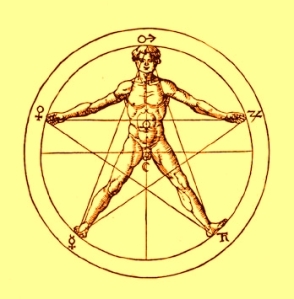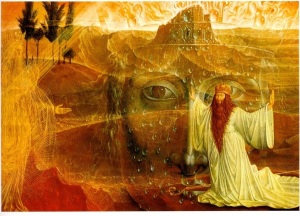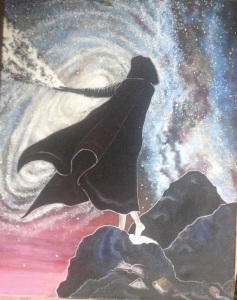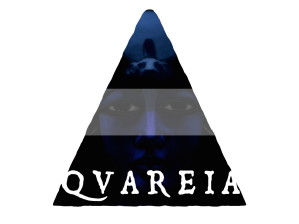The Quareia second module is now ready and will be soon uploaded. This module is about foundation patterns in magic. All magic exteriorises in a patterned form, usually as ritual, sometimes as an utterance or a series of sigils, which externalises the power and energy that the magician has tapped into. That power and energy is usually accessed through inner work, which is to say that first the magician connects through visionary magic with an inner energy and a consciousness (a being, a deity and so forth), and then bridges that energy in collaboration with a being, and gives it a form by working in ritual or with lettering, sigils, utterance, etc. That exteriorises the magic in our world and sends it off to do its job.
Before an apprentice magician can make that inner connection and work with raw energy, first they must learn what a pattern is, how it works, why it takes the shape it does and how that shape operates through the ritual pattern.
Often magical training only teaches the magician various ritual patterns without actually teaching why that pattern is as it is, what is coming through it, why it works or doesn’t, nor how it contains an energy in order for the ritual to have long and sustained effect. This lack of knowledge results in magicians repeating certain ritual acts that they learn from teachers or books, but they have no real in depth idea what it is they are doing nor why.
This in turn has resulted in magical ritual being melded with psychological drama rituals that are designed to make a person feel or think a certain way but they are not connected to a power source or to any consciousness outside of the magician. The end product of this approach results in all manner of problems, one of which is the loss of magic and the strengthening in the magician of a sense of control and egotism. It is time to reverse that trend away from manipulation and worship, and put back the gnosis and skill into magic.
The module looks at three foundational patterns that exist in western magic, and then looks at different ways of working with patterning that build upon those three foundation patterns. We look first at the directional pattern, which is a pattern that is common around the world in various ancient and modern cultures. It is a pattern that anchors power dynamics in combination with the elements and is about the land, working with the powers that flow through the land and how those power dynamics can be tapped in to focus power in a particular way.
The second pattern we look at is the Pentagram pattern, a widely misunderstood ritual pattern that is about ‘Man’ i.e. humanity and your individual humanity.  It places us within the wider pattern of existence, roots us in our ancestral blood lines, and bridges the directional pattern powers into form that we then use as magical tools. It also plugs us into the first step of understanding the creative Universal Power that flows through everything: the Pentagram is humanity stood between Divinity and the sacred land. That is where its power comes from; it is an anchor that triggers the conscious act of humanity as a fulcrum between all the worlds and all the powers. It is not a pattern you project out of your self for protection, rather it is pattern we step into and engage with.
It places us within the wider pattern of existence, roots us in our ancestral blood lines, and bridges the directional pattern powers into form that we then use as magical tools. It also plugs us into the first step of understanding the creative Universal Power that flows through everything: the Pentagram is humanity stood between Divinity and the sacred land. That is where its power comes from; it is an anchor that triggers the conscious act of humanity as a fulcrum between all the worlds and all the powers. It is not a pattern you project out of your self for protection, rather it is pattern we step into and engage with.
The third pattern we work with is the Hexagram pattern, again, a widely used pattern within ancient cultures that is about Divine completion. This is an exteriorisation of two opposing powers, polarities of energy and the existence of this Divine tension within everything that exists.
From these foundation patterns we learn how power flows into magic and then flows out into the world, and we learn how the magician as the fulcrum works with those powers, weaving them into patterned forms that will then effect change. Through this process of learning, the magician begins to realise how the magical tools work, why they are what they are, when to use them and when to not use them.
Magical learning is like slowly peeling layers away and looking carefully at each layer to see why it is there, what its function is and how we can interact with it. So that when the magician instigates a magical act, regardless of what that act is, the magician does it in full knowledge of what they are doing, what effect it will have and why. This in turn takes the dressing out of magic. The cultural and religious dressing of magic (the systems) is not the magic itself; it is the accent of magic. It is pointless being able to talk in a particular accent if you do not actually know the language you are speaking.
This in turn takes the dressing out of magic. The cultural and religious dressing of magic (the systems) is not the magic itself; it is the accent of magic. It is pointless being able to talk in a particular accent if you do not actually know the language you are speaking.
This module has ritual exercises, ritual actions, tasks, experiments, suggested research/reading, and also the beginning of magical work. It is vital for an apprentice to not just spend their time learning techniques, but to also engage those techniques in an actual job where they can begin the process of fully engaging with magic in order to achieve something. The ‘jobs’ are not for the benefit of the magician but for the benefit of the land around them.
This is because self focussed magic too early on in the training will steer the apprentice towards a dynamic that can quickly become unbalanced and counter productive. It is also very hard to be objective in a magic act when it is geared towards yourself. Some magical training starts with the magician ‘working upon themselves’ but more often than not it quickly becomes imbalanced and ineffective. By working from the very early phases of magic on something that is of no direct benefit to the magician, the apprentice is more able to be objective, balanced and is less likely to manipulate the power in a potentially destructive way.
The dynamics of magic have many different twists and turns: it is a complex art form and is not simple and straight forward, so the potential for fuck ups is great indeed. But if the magician learns to play in a sand box where there is little they can harm, they slowly learn how to make ever more complex shapes in the sand, they learn how to weigh volume, how to affect the substance and what working with sand actually feels like (and learns not to eat it).
So before the apprentice learns how to tap into power, first they learn what to do with that power: they learn to work with light bulbs, switches, wiring and plug sockets before the power is actually turned on. Next, in module three, they will learn what that power is once it has arrived at the threshold of manifest world: they learn about the electricity that reaches the house from its substation. Once they know about that power, what voltage it is, what it can do, how it is carried to the house, then they can learn to turn on the switch at the fuse box and allow the power to flow into the house.
Next, in module three, they will learn what that power is once it has arrived at the threshold of manifest world: they learn about the electricity that reaches the house from its substation. Once they know about that power, what voltage it is, what it can do, how it is carried to the house, then they can learn to turn on the switch at the fuse box and allow the power to flow into the house.
The foundation rituals are ones that the magician needs to be able to operate without thinking: they need to become as natural as walking. They are like choreographed dances that must be learned in an exact and accurate way in order for all the other dancers around them to be able to work without crashing into each other. So if you do this module, ensure that the ritual words and actions are drilled into your brain and body so that you could enact them without notice, anywhere, at any time. That way, the power, once it is switched on, has a solid dependable, predictable and strong circuit that it can flow through.
https://quareia.squarespace.com/#main



Pingback: Quareia – Module 2 now available. | Monsters and Magic
I love your articles like this, very clear and user friendly and down to earth. You don’t need me to tell you any of this, but the work you are doing now is truly an act of service.
LikeLiked by 1 person
What I love about Quareia so far is the instruction in core practices and methods without all the dogma or BS. I have always had one foot in magic and one in anthropology which has made it impossible to find the right “school” or teacher of magic. It’s hard to commit 100% to a particular dogma when you know some other dogma teaches the exact opposite yet also works. I thought maybe I should just pick one and stick with it, but could never find one that sat quite right with me or really rang true. It’s always been easy for me to see the general patterns in ritual cross-culturally, but observing that many cultures use (for example) smoke for purification doesn’t show you where the magic comes in, or how to relate to a power if it manifests. As a result I’d acquired a lot of intellectual trivia, but no practical application. And while I am blessed with a bit of natural talent, I had had no idea how to safely develop it. SO FRUSTRATING! But now I am a happy apprentice! And since I doubt I’m the only one out there who has been in this predicament, I hope the others find this course. Thanks again.
LikeLike
ahh, interesting indeed, Magic and anthropology can be a very interesting mix, as can magic and archaeology. And as you say, with such mixes, there is no room for bullshit, and there is no need for all that dressing anyhow. As you say, certain patterns are inherent across many cultures and landscapes, and it is more important to learn how to operate the pattern that to know its name and what colour it is and what it had for breakfast.
Let me know how you get on and you will find various things dropped into module 2 and 3 that as an anthropologist you will recognise.
Best wishes, Josephine
LikeLike